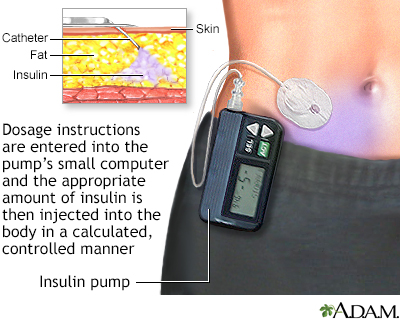Insulin pumps
Continuous subcutaneous insulin infusion; CSII; Diabetes - insulin pumps
An insulin pump is a small device that delivers insulin through a small plastic tube (catheter). The device pumps insulin continuously day and night. It can also deliver insulin more rapidly (bolus) before meals. Insulin pumps can help some people with diabetes have more control in managing blood glucose.
Images


Information
Most insulin pumps are about the size of a small mobile phone, but models keep getting smaller. They are mostly worn on the body using a band, belt, pouch, or clip. Some models now are wireless.
Traditional pumps include an insulin reservoir (cartridge) and a catheter. The catheter is inserted with a plastic needle just under the skin into fatty tissue. This is held in place with a sticky bandage. Tubing connects the catheter to a pump that has a digital display. This allows the user to program the device to deliver insulin as needed.
Patch pumps are worn directly on the body with the reservoir and tubes inside a small case. A separate wireless device programs insulin delivery from the pump.
Pumps come with features such as waterproofing, touchscreen, and alerts for dosage time and insulin reservoir capacity. Some pumps can connect or communicate with a glucose sensor to monitor blood glucose levels (continuous glucose monitor or CGM). This allows you (or in some cases the pump) to stop insulin delivery if blood glucose is becoming too low. Talk to your health care provider about which pump is right for you.
HOW INSULIN PUMPS WORK
An insulin pump delivers insulin continuously to the body. Except in rare circumstances, the device usually uses only rapid-acting insulin. It can be programmed to release different doses of insulin based on your blood glucose levels. Insulin doses are of three types:
- Basal dose: A small amount of insulin delivered all day and night. With pumps you can change the amount of basal insulin being delivered at different times of day. This is the biggest advantage of pumps over injected insulin because you can customize the amount of basal insulin you are getting at different times of day.
- Bolus dose: A higher dose of insulin at meals when blood sugar levels rise due to carbohydrates in food. Most pumps have a 'bolus wizard' to help calculate the bolus dose based on your blood glucose level and the meal (grams of carbohydrate) you are eating. You can program the pump to deliver the bolus doses in different patterns. This is also an advantage over injected insulin for some people.
- A correction or a supplemental dose as needed.
You can program the amount of a dose according to your blood sugar levels at different times of the day.
The benefits of using an insulin pump include:
- Not having to inject insulin
- More discrete than injecting insulin with a syringe
- More accurate insulin delivery (can deliver fractions of units)
- May help with tighter blood glucose control
- Fewer big swings in blood glucose levels
- May result in improved A1C
- Fewer episodes of hypoglycemia
- More flexibility with your diet and exercise
- Helps manage 'dawn phenomenon' (early morning rise in blood glucose levels)
Disadvantages of using insulin pumps are:
- Increased risk of weight gain
- Increased risk of diabetic ketoacidosis if pump does not work correctly
- Risk of skin infection or irritation at the application site
- Need to be attached to the pump most of the time (for example, at the beach or at the gym)
- Need to operate pump, replace batteries, set doses, and so on
- Wearing the pump makes it obvious to others that you have diabetes
- It can take a while to get the hang of using the pump and keeping it working properly
- Have to check your blood sugar levels several times a day and count carbohydrates
- More expensive than taking insulin by injections
HOW TO USE THE PUMP
Your diabetes team (and the pump manufacturer) will help you learn everything you need to know to use the pump successfully. You will need to know how to:
- Keep track of your blood sugar levels (much easier if also using a continuous glucose monitor)
- Count carbohydrates
- Set basal and bolus doses and program the pump
- Know what doses to program each day based on the amount and type of food eaten and physical activities performed
- Know how to account for sick days when programming the device
- Connect, disconnect, and reconnect the device, such as during showers or vigorous activity
- Manage high blood glucose levels
- Know how to watch for and avoid diabetic ketoacidosis
- Know how to deal with pump problems and spot common errors
Your health care team will train you to check your blood sugar levels to adjust the doses.
Insulin pumps continue to be improved and have changed a lot since they were first introduced.
- Many pumps now communicate wirelessly with continuous glucose monitors (CGMs).
- Some feature an 'auto' mode that changes the basal dose based on whether your blood sugar is increasing or decreasing. (This is sometimes referred to as a 'closed loop' system).
TIPS FOR USE
Over time, you will become more comfortable using an insulin pump. These tips may help:
- Take your insulin at set times so you don't forget doses.
- Be sure to track and record your blood sugar levels, exercise, carbohydrate amounts, carbohydrate doses, and correction doses and review them daily or weekly. Doing so will help you improve blood glucose control.
- Talk with your provider about ways to avoid gaining weight when you start using the pump.
- If you're traveling, be sure to pack extra supplies.
- Your provider should prescribe extra insulin in a vial and syringe form in case there is any pump malfunction requiring manual injections.
When to Call Your Health Care Provider
Contact your provider if:
- You have frequent low or high blood glucose levels
- You have to snack between meals to avoid low blood glucose levels
- You have a fever, nausea, or vomiting
- An injury
- You need to have surgery
- You have unexplained weight gain
- You are planning to have a baby or become pregnant
- You start treatments or medicines for other problems
- You stop using your pump for an extended time
References
American Diabetes Association. 9. Pharmacologic approaches to glycemic treatment: Standards of Medical Care in Diabetes-2022. Diabetes Care. 2022;45(Suppl 1):S125-S143. PMID: 34964831 pubmed.ncbi.nlm.nih.gov/34964831/.
Aronson JK. Insulin. In: Aronson JK, ed. Meyler's Side Effects of Drugs. 16th ed. Waltham, MA: Elsevier; 2016:111-144.
Atkinson MA, Mcgill DE, Dassau E, Laffel L. Type 1 diabetes mellitus. In: Melmed S, Auchus RJ, Goldfine AB, Koenig RJ, Rosen CJ, eds. Williams Textbook of Endocrinology. 14th ed. Philadelphia, PA: Elsevier; 2020:chap 36.
National Institute of Diabetes and Digestive and Kidney Diseases website. Insulin, medicines, & other diabetes treatments. www.niddk.nih.gov/health-information/diabetes/overview/insulin-medicines-treatments. Updated March 2022. Accessed November 7, 2022.
BACK TO TOPReview Date: 8/12/2022
Reviewed By: Sandeep K. Dhaliwal, MD, board-certified in Diabetes, Endocrinology, and Metabolism, Springfield, VA. Also reviewed by David C. Dugdale, MD, Medical Director, Brenda Conaway, Editorial Director, and the A.D.A.M. Editorial team.

Health Content Provider
06/01/2025
|
A.D.A.M., Inc. is accredited by URAC, for Health Content Provider (www.urac.org). URAC's accreditation program is an independent audit to verify that A.D.A.M. follows rigorous standards of quality and accountability. A.D.A.M. is among the first to achieve this important distinction for online health information and services. Learn more about A.D.A.M.'s editorial policy, editorial process and privacy policy. A.D.A.M. is also a founding member of Hi-Ethics. This site complied with the HONcode standard for trustworthy health information from 1995 to 2022, after which HON (Health On the Net, a not-for-profit organization that promoted transparent and reliable health information online) was discontinued. |
The information provided herein should not be used during any medical emergency or for the diagnosis or treatment of any medical condition. A licensed medical professional should be consulted for diagnosis and treatment of any and all medical conditions. Links to other sites are provided for information only -- they do not constitute endorsements of those other sites. © 1997- 2024 A.D.A.M., a business unit of Ebix, Inc. Any duplication or distribution of the information contained herein is strictly prohibited.
